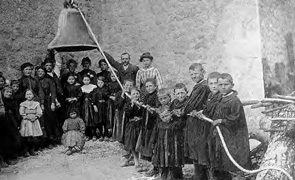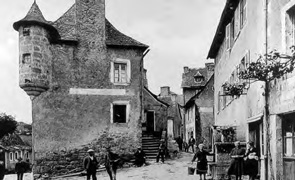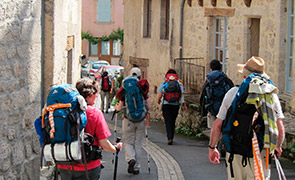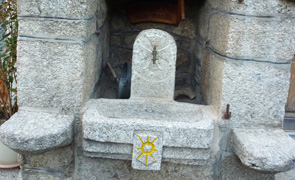 Espeyrac
Espeyrac
Espeyrac
The church

[la glèisa]
In the 15C, the feudal castle, in ruins, was turned into a church. The chevet wall, with red sandstone and granite crosses from the castle chapel*, is the oldest part of the present-day building, reconstructed in the 19C.
* It served as the parish church.
Espeyrac
The Château

[lo castèl]
The second château in Espeyrac dates back to the 15C-16C. It was the home of the viguier, the person who managed the property belonging to the feudal overlords of Espeyrac (Armagnac-Séverac, then Arpajon).
This building was broken up into lots during the Revolution and all that remains is a lovely turret.
Espeyrac
Espeyrac

[Espeyrac]
The old Gallo-Roman domain of Spariacus, now called Espeyrac, is mentioned in the 11C in the cartulary of Conques abbey, but it is especially through the miracle of Witbert (Guilbert) whose sight was restored, related in the Book of Miracles of Sainte Foy,
that the village became famous.
In 1356, it was fortified and became the seat of an important barony (of Arpajon) until 1661. All that remains of the medieval village is the amphitheatre-style layout on a rocky peak, steeply sloped streets and alleyways with steps. The old church was completely rebuilt at the end of the 19C.
Of the two châteaux, there is only a building with a turret that remains. However, there is no visible sign of the mills used to hammer iron or copper that were located along the Daze.
At the end of the 19C, Espeyrac had three annual fairs and got two extra ones, which shows just how lively this small town was.
Prior to 1914, there were three blacksmiths, a weaver (hemp for textiles), two seamstresses/milliners, a haberdasher, an inn keeper, a cobbler, a clog-maker/barber/hairdresser, tilers and more; the hustle and bustle was in complete contrast with the peacefulness of today. Welcome to our visitors!
The Miracle of Guilbert
Back from a pilgrimage to Conques, Géraud (Guilbert's godfather), who was jealous of Guilbert in whom he saw a rival, had him arrested, sentenced him to lose his sight and put out Guilbert's eyes with his own hands.
A year later, on the eve of Sainte Foy's Day, Guilbert saw the martyr in his sleep. He went to Conques and regained his sight.
The underground refuge places
[las cavas]
'At the end of the tunnel, a white stone...'. ». As in most of the villages on the plateau, there is evidence, in the memory of Espeyrac, of an underground room so that the population could flee from pillagers.
Although some of them are known (such as in Espeyrac), most of them are only hiding places, below ground, having nothing in common with the fabled long underground passages linking the church or château to a safe place.
Must-sees
A short tour to discover the village has been set up as part of developing the Route of Santiago de Compostela. It will enable you to learn about the history of the village and to discover the most significant elements relating to its heritage (see map).
Espeyrac
The mysterious head
[lo cap estranh]
Located where the bartizan projects out of the wall, this granite head, with its rough-hewn eyes and mouth, is a complete mystery.
Is it an old sculpture worn away by time, is it a naïve work of art, or is it just a fluke of nature?
A similar sculpture can be found close by, in the hamlet of Saint Bauzels, and also in Auvergne on the Way of Saint James.
Espeyrac
The sarcophagi
[ataücs]
The presence of several Carolingian sarcophagi, made of sandstone or granite, teaches us a little bit more about the village before the 10C, because, in those times, a cemetery also meant a church and the bases of a medieval society.
Most of these sarcophagi were reused to rebuild the church: they were used as the foundation to erect the wall, and the crosses found in the masonry are from the tops that were re-hewn.
Espeyrac
The well

[lo potz]
Dated 1825.
Several similar wells, now disappeared, in Sénergues and at the Domaine de la Borie, were crafted by the same local mason.
Espeyrac
The wash house
[lo lavador]
In the past, the women of Espeyrac would go to wash their laundry in the Daze.
In the Thirties, when the first water conveyance was created, the wash house was built in the middle of the village so the women didn't have to go down to the river to wash their clothes.
Espeyrac
Cutlery
[la cotelariá]
Ironworking is very much part of Espeyrac's history. With a strong presence up until the end of the Middle Ages, it disappeared along with the last blacksmith in the middle of the 20C; it has been revived today in the Denys forge (cutlery and jewellery) with a splendid project: using local ore.









































